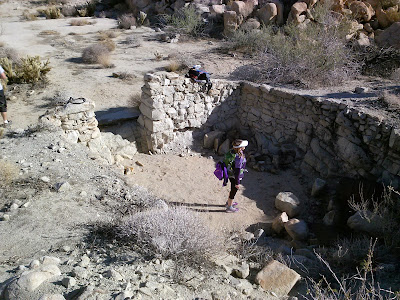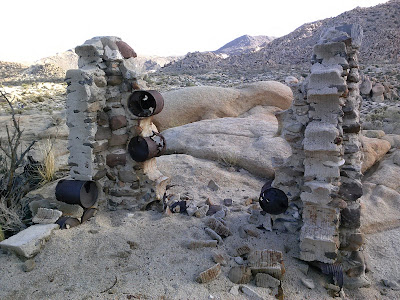It looks like this has turned out to be my annual November hike. The Goat Canyon Trestle is an engineering marvel on the “impossible” San Diego and Arizona Railway that was constructed between 1907 and 1919 along the rugged Carrizo Gorge. The world's largest wooden trestle was built in 1932 after an earthquake destroyed one of the tunnels, forcing the railroad engineers to bridge Goat Canyon. This spectacular trestle remains to this day for adventure minded people to find deep within a rugged wilderness.
For more history on this railroad, check out the link below.
San Diego's "Impossible Railroad"
For my last trip report here, check out this link: Goat Canyon Trestle Hike - November 2012
For my last trip report here, check out this link: Goat Canyon Trestle Hike - November 2012
Riding along with with my friend Steve and his girlfriend Tammy, we make our way along Mortero Wash to Dos Cabezas Road along a portion of railroad tracks to drop off a vehicle at our ending point.
Ominous looking clouds in the distance.
Starting out at Mortero Palms trail head.
There's plenty of rock scrambling to be had early on in this hike.
Steve, posing at this rocky overhang.
Hey, I gotta get in on this too.
Looking back at our progress so far.
There's still a lot of climbing to do. From here you can see the wind farm just West of the town of Ocotillo.
Making progress through the boulder strewn pass.
Soon we come upon Mortero Palms oasis.
On a warm day these palms make for a relaxing break from the sun and heat.
Just past the palms we had to ascend up this narrow, smooth, dry waterfall.
Once at the top we had a great view of the palms and desert below.
The route ahead still has a few boulders to negotiate.
Time for a short snack break.
If you look closely at the large boulder in the center of the photo you'll notice a Yoni (female fertility symbol, or "Yoni" petroglyph) carved in the center by ancient Native Americans.
Once at the top of the first ridge we descend down into a canyon before climbing up the next ridge.
Watch your footing here and beware the cholla.
Still climbing...
Here's the highest point along the hike. Its all downhill from here.
The upper reaches of Goat Canyon have a few dry waterfalls that need to be negotiated or bypassed.
Our first glimpse of the "Seven Sisters" railroad trestles along Carrizo Gorge in the distance.
At last, Goat Canyon Trestle comes into view.
There are still a few treacherous descents ahead of us.
Looking back up the way we came down.
After a lunch break and exploring the area for a bit it was time to continue on our way to the old railroad workers camp.
A group of motorcyclist passed by in one of the tunnels.
Carrizo Creek snakes its way through the gorge below.
I figured it was about time I climb down these derailed box cars...
...without falling off the mountain!
Site of the railroad workers camp, built from discarded back powder cans during the construction of the railroad. (See my 2012 trip report for this hike to see an earlier photo of this site.)
From here we decided to look for the Blue Sun Cave near Indian Hill.
While traveling cross-country we came upon many areas that had pottery shards strewn about.
Archaeologists tell us that this area has been inhabited as far back as 6,000 years ago by the Kumeyaay and their ancestors.
Of course, left them to let other adventure minded folk find them again.
Native American grinding holes, or morteros.
Indian Hill is a a large rock pile of decomposing granite boulders that lends itself to numerous rock caves and shelters. The Blue Sun Cave gets its name from a blue sun pictograph in side it, along with many others.
We never found the cave. I think we were too far north and after doing some more research, I have a better understanding of were it might be. So that'll be an adventure for another day.
And so our trip comes to an end. Hiking out to Goat Canyon Trestle is truly an epic one-day adventure that I look forward to each year.



















































































No comments:
Post a Comment